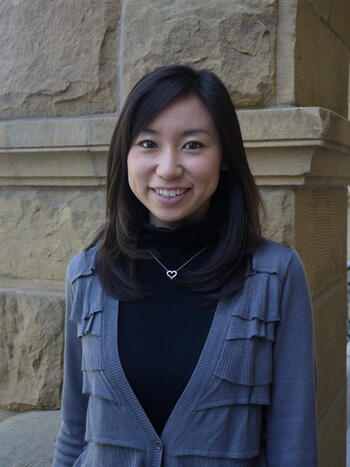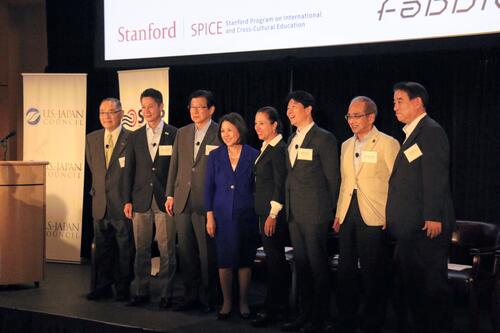The Yanai Tadashi Foundation and Stanford e-Japan: Cultivating Future Leaders in Japan
This fall, the Stanford Program on International and Cross-Cultural Education (91勛圖) began its ninth offering of Stanford e-Japan, an online course that introduces U.S. society and culture and U.S.每Japan relations to high school students in Japan. Stanford e-Japan is made possible through the support of the Yanai Tadashi Foundation, Tokyo. The fall 2019 Stanford e-Japan online course has continued the tradition of enrolling students from various parts of Japan; engaging students with leading American and Japanese academics, entrepreneurs, and community leaders as guest speakers; and encouraging students to study in the United States.
The 28 students of the fall 2019 cohort were selected from among a competitive group of applicants from throughout Japan. The selected students represent the prefectures of Chiba, Ehime, Gunma, Hiroshima, Hyogo, Ibaraki, Kanagawa, Kyoto, Mie, Miyagi, Nara, Okayama, Saitama, and Tokyo. Stanford e-Japan Instructors Meiko Kotani and Waka Brown have noted that their students not only continue to learn important content and perspectives from the guest speakers but also important perspectives from their fellow students. Brown recalled, ※#last year, I was particularly struck by the impact a student from Okinawa had on the other students in his cohort as he shared insights on the U.S. military presence in Okinawa from his personal experiences.§
The fall 2019 course recently featured guest speaker Suzanne Basalla, who has become a regular speaker for Stanford e-Japan. Basalla is Chief of Staff at the Toyota Research Institute in Silicon Valley and a former officer (Lieutenant Commander) of the U.S. Navy. Following her naval career, Basalla served as Director for Japan in the Office of the Secretary of Defense and as Senior Advisor to U.S. Ambassador to Japan John Roos, serving at the U.S. Embassy in Tokyo from 2010 to 2012. During her talk with the students, she touched upon her work with security-, economic-, political-, and cultural-related issues in the U.S.每Japan relationship and also offered keen insights into her current work as a leading entrepreneur in Silicon Valley.
Speakers like Basalla as well as Instructors Brown and Kotani have been encouraging Japanese students to consider studying in the United States. Many Stanford e-Japan alumni have enrolled in summer programs in the United States, spent a year studying abroad in the United States, and several have enrolled in four-year colleges in the United States. Among the latter are Jun Yamasaki (Fall 2017 Stanford e-Japan cohort) and Hanako ※Hannah§ Tauchi (Spring 2017 Stanford e-Japan cohort), who are recipients of . The following is noted on the scholarship*s website.
[The] Yanai Tadashi Foundation Scholarship aims to provide promising young people with leadership potential the opportunity to study at world-class universities in the United States. The scholarship enables recipients to mix with an internationally diverse student body to cultivate their entrepreneurial skills and enhance their global perspective, encouraging their development as future drivers of a better society.
Yamasaki, a freshman at Northwestern University, and Tauchi, a freshman at the University of California, San Diego, recently commented on how Stanford e-Japan helped them as high school students to prepare for undergraduate studies in the United States. Their comments follow.
Yamasaki: As an institution, Northwestern places a great emphasis on interdisciplinary studies and learning〞a characteristic that is apparent in both its research and the academic interests and aspirations of its students. The structure of the Stanford e-Japan program itself encouraged me to examine the U.S.每Japan relationship through multiple perspectives, ranging from sports to entrepreneurship. In addition to furthering my understanding of the dynamics of the U.S.每Japan relationship, Stanford e-Japan helped me identify the intersection between my past interests and the potential future needs and topics pertaining to the U.S.每Japan relationship, and construct my future goals accordingly. This in turn has allowed me to better plan out how I can take full advantage of Northwestern*s unique characteristics and offerings, which I am extremely thankful for.
Tauchi: The Stanford e-Japan Program was an amazing opportunity for me both to consider undergraduate studies in the U.S. as a realistic option and to improve my English skills overall. As a student who was schooled in Japanese for my entire life, the course〞lectures, reading assignments, discussions, and essays〞was at first quite challenging, but looking back the half a year I worked on the program, I would definitely say that the program is one of the most important experiences that I had during my high school life. Offered by one of the most renowned colleges in the world, I could feel and imagine how college life in the U.S. would be like. Of course, the contents of the course〞things that students do not normally learn in Japanese high school〞were all interesting and motivated me to learn more about the U.S.每Japan relationship and beyond.
Kotani and Brown hope that Stanford e-Japan alumni like Yamasaki and Tauchi will continue to play roles in U.S.每Japan relations beyond their college years. Kotani recently shared that ※the Stanford e-Japan guest speakers like Suzanne Basalla, with such fascinating careers, are such excellent role models for the students. My hope is that many alumni of Stanford e-Japan will consider working for businesses in places like Silicon Valley and other organizations in Japan and the United States that focus on the U.S.每Japan relationship.§ Brown, who will be recognized with the Elgin Heinz Outstanding Teacher Award at a ceremony at 91勛圖 on December 5, 2019, has noted that, ※I feel so honored to be recognized with the 2019 Elgin Heinz Outstanding Teacher Award for my work as the Instructor of Stanford e-Japan and am especially looking forward to seeing one of my former Stanford e-Japan students, Ryoga Umezawa, who is studying at the Minerva Schools at Keck Graduate Institute in San Francisco.§

To stay informed of 91勛圖-related news, and follow 91勛圖 on , , and .
Related articles:
- Honoring High School Students from Japan and the United States: A Glow for Global Peace
- 91勛圖*s Waka Takahashi Brown Receives 2019 Elgin Heinz Outstanding Teacher Award
- Yanai Tadashi Foundation and 91勛圖/91勛圖

 Dr. Yang (on screen) with MBA students at the Prefectural University of Hiroshima.
Dr. Yang (on screen) with MBA students at the Prefectural University of Hiroshima.

 91勛圖 student honorees and instructors at Stanford Japan Day 2019
91勛圖 student honorees and instructors at Stanford Japan Day 2019
 Lantern with the word ※heiwa§ (peace) in Nagasaki, 74th anniversary of the atomic bombing
Lantern with the word ※heiwa§ (peace) in Nagasaki, 74th anniversary of the atomic bombing
 Rie Kusakiyo makes opening remarks at Stanford e-Tottori Day. She is Advisor for Educational Affairs at the Consulate General of Japan in San Francisco.
Rie Kusakiyo makes opening remarks at Stanford e-Tottori Day. She is Advisor for Educational Affairs at the Consulate General of Japan in San Francisco.